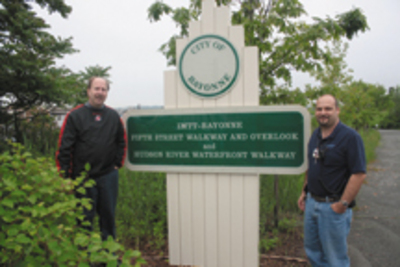At the southeastern corner of Bayonne rests the wreck of the Estelle Krieger, an 1,172-ton passenger schooner built in 1899, but left to rot along the piers of the Port Johnson Coal Docks along with the five-masted Barkentine ship The Macerata.
Listed as a feature of a New York Harbor “ship ruins tour,” these two ships, along with two other smaller boats, used to be largely invisible from the shore.
While a path did exist along the shore from an area near East Fifth Street to the former Port Johnson dock, it was an overgrown path used by city workers to access to a city stormwater pipe and maintenance shed and by kids wandering to the waterside after dark.
This year, thanks to a gift from the local chemical company IMTT, the path was widened, weeded, and opened to the public as the newest member of the city’s park system.
Path to schooner
The path runs for about three quarters of a mile along one of the most remote portions of Bayonne, an area not previously open to the general public.
“We still have some work to do, but we opened it in the spring.” – Gary Chmielewski
________
People like author Mark Twain occasionally visited here for a rest and a sail.
But with the industrialization of Bayonne, this part of the world found itself isolated in the midst of oil tanks and other heavy industry. Indeed, nearby are the remains of the old Johnson Coal Yards.
“The park was built in lieu of public access on IMTT property,” said Gary Chmielewski, director of the Department of Public Works.
In exchange for permits to construct a trestle along the waterfront, IMTT agreed to build the pathway as a park at the cost of $400,000.
“IMTT needed to something on waterfront property to compensate, so it created this,” said Chmielewski.
At low tide, you can see the four ships resting in the mud flats at the end of the path.
A small marker stands at the observation post at the far end, listing the names of the ship.
Along with clearing the path of reeds and debris, IMTT also planted 10 maple and walnut trees, joining the cluster of birch trees already lining the path.
The path also features 26 lights, powered by solar panels and a series of benches built out of recycled plastic.
“We still have some work to do, but we opened it in the spring,” Chmielewski said. “I think it is a great addition to our park system.”
The facility has seven parking spaces for residents’ use, and like other city parks, is open from 8 a.m. to dusk each day.
Jimmy Cilino, superintendent for the Parks Department, said staff visits the park frequently to check on wear and tear and maintain the path. He said some of the plants are typical of wetlands, so this park joins Ratkowski Park as a kind of natural preserve.
Al Sullivan may be reached at asullivan@hudsonreporter.com.
